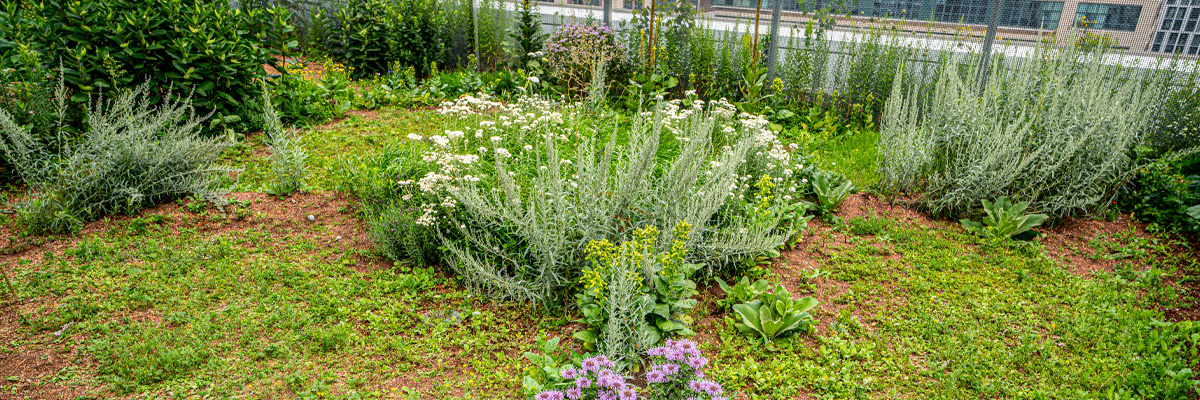Indigenous Foodways

The Indigenous Foodways program aims to promote Indigenous wisdom and traditional agricultural practices through knowledge exchange and community engagement. Emphasizing the importance of honorable practices, the Indigenous Foodways program aims to uphold the principles of an honorable harvest by maximizing the social and ecological impact. This includes growing traditional medicines and making them accessible to the community while building meaningful and respectful relationships of reciprocity.
Indigenous Foodways program history

Established in 2021 as a pilot, two plots on the ENG roof were selected to grow culturally significant crops and medicines for the Indigenous Foodways program, culminating in the development of the Medicine Garden and Three Sisters Garden.
The design of both gardens was carefully planned to include traditional companion planting methods and Indigenous ways of growing.
The Indigenous Foodways program expanded in Spring 2022 and is located on the DCC rooftop. In collaboration with the Black Food Sovereignty initiative, the DCC is the new home to the Indigenous Foodways Program and Medicine Garden.
The DCC features an Indigenous medicine garden and culturally significant crops, including the three sisters, berries, trees and pollinators that are locally Indigenous. Currently growing on the rooftop are raspberries, elderberry, blackberries, strawberries, and baby Juniper and cedar trees. In addition to the Indigenous Foodways crops, the Black Food Sovereignty initiative grows crops and medicines that are culturally significant to the African diaspora and offers programs through the Harvest Collective and Learning Circle.
What we grew
In 2022, the Medicine Garden grew 41 Indigenous medicines using traditional growing methods. Medicines grown at the Urban Farm were distributed to Indigenous community groups both on- and off-campus, including Gdoo-maawnjidimi Mompii Indigenous Student Services, the X University Pow Wow, Miziwe Biik Aboriginal Employment and Training (external link) , Native Learning Centre (external link) and the Native Women’s Resource Centre of Toronto (external link) (NWRCT).
Some of the crops grown at the Farm include:
- Amaranth
- Aster
- Chamomile
- Echinacea
- Evening primrose
- Lavender
- Marigold
- Marshmallow
- Milkweed
- Mint
- Peppermint
- Rosemary
- Sage
- Skullcap
- Strawberries (two cultivars)
- Sweetgrass
- Thyme
- Tobacco
- Valerian
- Yarrow
Some of the new crops grown in 2022 include:
- Pearly Everlasting
- Ground cherry
- Blueberry
- Black raspberry
- Red raspberry
- Uva Ursi
- Elderberry
- Juniper
- Eastern white cedar
- Wild Licorice
- Ginger Mint
- Wild Dog Rose
- Honeysuckle
- Sumac
- and more!
What is the Medicine Wheel?

For many Indigenous nations across North America, the Medicine Wheel serves as a powerful metaphor for the interconnectedness of life, represented as a “sacred circle”. The most iconic and recognizable Medicine Wheel is a circle divided into four sections coloured black, white, red and yellow.
Interpretations of the teachings of the Medicine Wheel vary by nation, but the four quadrants of the Medicine Wheel most commonly represent the four seasons, the four stages of life (birth, youth, adulthood, elderhood) and the Four Directions. In the case of the Four Directions, each direction is associated with one of the Four Sacred Plants: tobacco (East), sweetgrass (South), sage (West) and cedar (North).
Design of the Medicine Garden

Inspired by the Medicine Wheel and what it represents, a sacred circle sits at the heart of the garden’s design. We planted sacred Indigenous medicines in a circle, with sweetgrass at the centre of the plot encircled by tobacco. A border of sage was planted in raised beds, dividing the Medicine Garden into the Four Directions, representing East, South, West and North. The four corners of the garden were planted with a variety of other medicinal plants to create an aesthetic border and protect the plants growing in the interior.
What we grow
The Three Sisters Garden was planted with a middle row of corn, dividing the plot into two sections and creating a “wall” of corn. Beans were planted on either side of the corn, allowing them climb up the corn stalks towards the light. Two types of squash were planted around the base of the beans and corn, with one side consisting of butternut squash and the other acorn winter squash. The four corners of the Three Sisters Garden were bordered by sunflowers planted on slightly raised beds. Sunflowers are sometimes referred to as the “fourth” sister as they support the beans and lure birds away from the corn while attracting pollinators.

Who are the Three Sisters?
In Iroquois (Haudenosaunee) mythology, the Three Sisters represent the staple crops of corn, beans and squash. When planted together, the Three Sisters protect and support one another, ultimately providing a balanced, nutrient-dense diet that could sustain Iroquois communities throughout the harsh winter months.
An effective form of companion planting, this triad of crops grow symbiotically when planted together. Corn, the first Sister, is the first to be planted and its stalks provide a natural trellis for beans, the second Sister, to climb towards the sunlight. As they climb, the tendrils of the beans bind the stalks together, stabilizing them against the wind while also returning nitrogen to the soil and fertilizing its sisters. The wide leaves of squash, the third Sister, provide shade and cover to the base of its sisters, keeping the soil moist and deterring the growth of weeds.
Collaboration and requests
The Indigenous Foodways Programs welcomes requests for tours, programming, and collaborations by Indigenous-led internal and external groups. Tours of the Indigenous Foodways crops and medicine garden will be led by Samantha Williams, the Indigenous-Led Programs Coordinator. If you have an idea or request that supports the goals of this initiative, please email swilliamsbarrantes@torontomu.ca or visit our Tours page to book a time to see the Indigenous Foodways and Medicine Garden.







